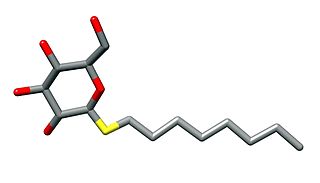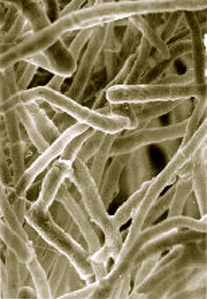
n-Octyl β-d-thioglucopyranoside is a mild nonionic detergent that is used for cell lysis or to solubilise membrane proteins without denaturing them. This is particularly of use in order to crystallise them or to reconstitute them into lipid bilayers. It has a critical micelle concentration of 9 mM.
In chemistry, acetylation is an organic esterification reaction with acetic acid. It introduces an acetyl group into a chemical compound. Such compounds are termed acetate esters or simply acetates. Deacetylation is the opposite reaction, the removal of an acetyl group from a chemical compound.
Endo-1,4-β-xylanase is any of a class of enzymes that degrade the linear polysaccharide xylan into xylose, thus breaking down hemicellulose, one of the major components of plant cell walls:

Trichoderma reesei is a mesophilic and filamentous fungus. It is an anamorph of the fungus Hypocrea jecorina. T. reesei can secrete large amounts of cellulolytic enzymes. Microbial cellulases have industrial application in the conversion of cellulose, a major component of plant biomass, into glucose.

Trichoderma is a genus of fungi in the family Hypocreaceae that is present in all soils, where they are the most prevalent culturable fungi. Many species in this genus can be characterized as opportunistic avirulent plant symbionts. This refers to the ability of several Trichoderma species to form mutualistic endophytic relationships with several plant species. The genomes of several Trichoderma specieshave been sequenced and are publicly available from the JGI.
In enzymology, a deacetoxycephalosporin-C hydroxylase (EC 1.14.11.26) is an enzyme that catalyzes the chemical reaction
Azobenzene reductase also known as azoreductase (EC 1.7.1.6) is an enzyme that catalyzes the chemical reaction:
The enzyme carboxylesterase (or carboxylic-ester hydrolase, EC 3.1.1.1; systematic name carboxylic-ester hydrolase) catalyzes reactions of the following form:
The enzyme feruloyl esterase (EC 3.1.1.73) catalyzes the reaction
The enzyme sialate O-acetylesterase (EC 3.1.1.53) catalyzes the reaction
For beta-glucuronidase, see Beta-glucuronidase
In enzymology, a N-acyl-D-glutamate deacylase (EC 3.5.1.82) is an enzyme that catalyzes the chemical reaction
In enzymology, a (S)-N-acetyl-1-phenylethylamine hydrolase (EC 3.5.1.85) is an enzyme that catalyzes the chemical reaction
In enzymology, a deacetylcephalosporin-C acetyltransferase is an enzyme that catalyzes the chemical reaction
In enzymology, a 1,3-beta-galactosyl-N-acetylhexosamine phosphorylase is an enzyme that catalyzes the chemical reaction
In molecular biology, glycoside hydrolase family 75 is a family of glycoside hydrolases.
Exo-1,4-beta-D-glucosaminidase is an enzyme with systematic name chitosan exo-(1->4)-beta-D-glucosaminidase.! This enzyme catalyses the following chemical reaction
Throughout human history, fungi have been utilized as a source of food and harnessed to ferment and preserve foods and beverages. In the 20th century, humans have learned to harness fungi to protect human health, while industry has utilized fungi for large scale production of enzymes, acids, and biosurfactants. With the advent of modern nanotechnology in the 1980s, fungi have remained important by providing a greener alternative to chemically synthesized nanoparticle.
Aliphatic (R)-hydroxynitrile lyase (EC 4.1.2.46, (R)-HNL, (R)-oxynitrilase, (R)-hydroxynitrile lyase, LuHNL) is an enzyme with systematic name (2R)-2-hydroxy-2-methylbutanenitrile butan-2-one-lyase (cyanide forming). This enzyme catalyses the following chemical reaction:
(S)-hydroxynitrile lyase (EC 4.1.2.47, (S)-cyanohydrin producing hydroxynitrile lyase, (S)-oxynitrilase, (S)-HbHNL, (S)-MeHNL, hydroxynitrile lyase, oxynitrilase, HbHNL, MeHNL, (S)-selective hydroxynitrile lyase, (S)-cyanohydrin carbonyl-lyase (cyanide forming), hydroxynitrilase) is an enzyme with systematic name (S)-cyanohydrin lyase (cyanide forming). This enzyme catalyses the interconversion between cyanohydrins and the carbonyl compounds derived from the cyanohydrin with free cyanide, as in the following two chemical reactions:



